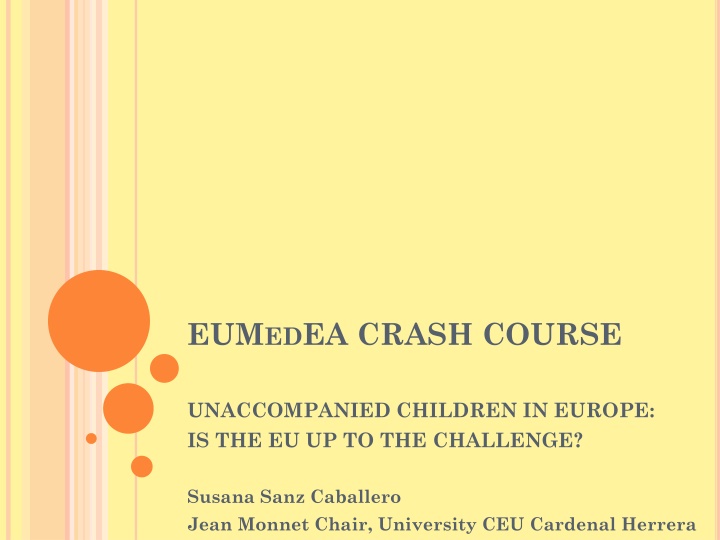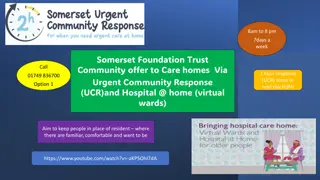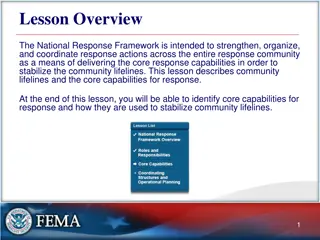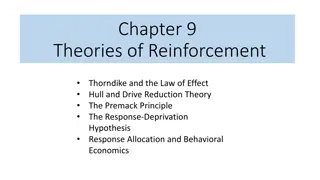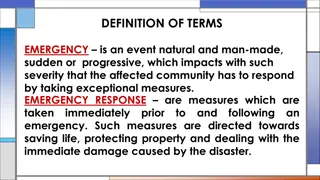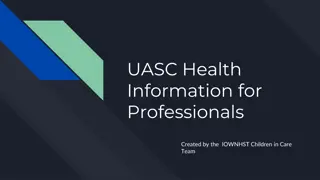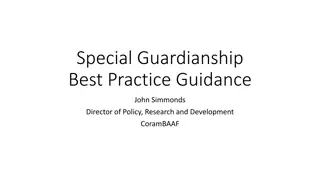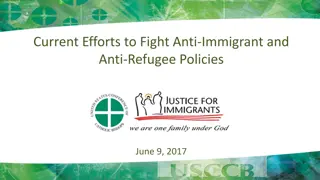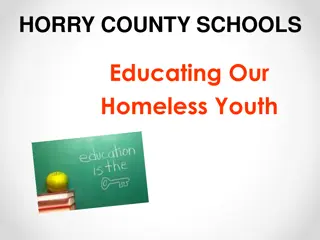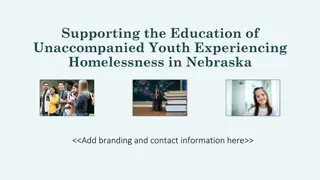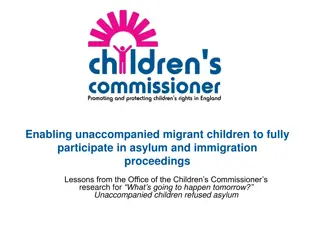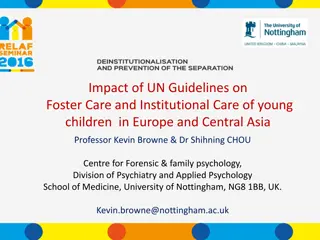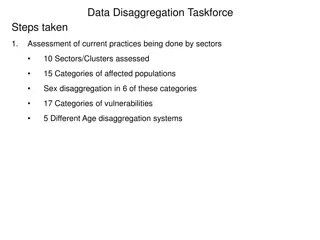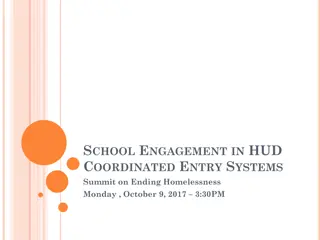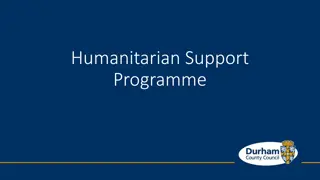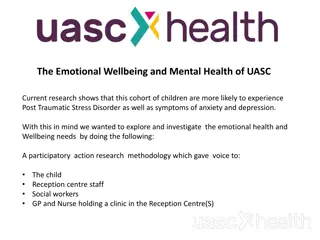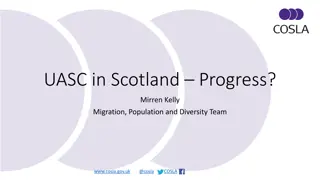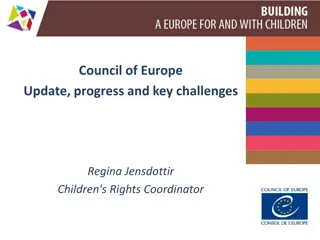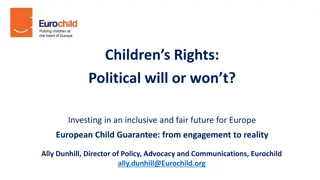Unaccompanied Children in Europe: Challenges and EU Response
The article explores the challenges faced by unaccompanied children in Europe, emphasizing the need for international protection and proper application of EU norms. It delves into reasons for children fleeing, concerning practices by certain countries, and the scarce legal framework. The concept of best interests of the child is scrutinized, highlighting the lack of a cohesive system for protecting unaccompanied children in the EU.
Download Presentation

Please find below an Image/Link to download the presentation.
The content on the website is provided AS IS for your information and personal use only. It may not be sold, licensed, or shared on other websites without obtaining consent from the author.If you encounter any issues during the download, it is possible that the publisher has removed the file from their server.
You are allowed to download the files provided on this website for personal or commercial use, subject to the condition that they are used lawfully. All files are the property of their respective owners.
The content on the website is provided AS IS for your information and personal use only. It may not be sold, licensed, or shared on other websites without obtaining consent from the author.
E N D
Presentation Transcript
EUMEDEA CRASH COURSE UNACCOMPANIED CHILDREN IN EUROPE: IS THE EU UP TO THE CHALLENGE? Susana Sanz Caballero Jean Monnet Chair, University CEU Cardenal Herrera
We must ensure that all children, particularly those without paternal care, receive international protection and are safe from those who violate their rights and deprive them of their childhood. Ultimately, it should children, no matter their status, are children after all and should be treated as such . be remembered that Constantinos Manolopoulos Interim Director, EU Fundamental Rights Agency
Asylum-seeking children and children refuges are among the most vulnerable groups Due to the increasing flux, the EU is applying neither int l nor EU norms correctly We do not know the exact dimension of the problem
REASONS FOR CHILDREN FLEEING AWAY War Terrorism Hunger Human trafficking Poverty Drought Climate change Catastrophes Domestic violence Underdevelopment Siren calls from mafias & local media
SOME PRACTICES NOT TO BE FOLLOWED Greece UK Spain and Malte Art. 18 CRC Art. 30 Directive on the conditions governing eligibility for refugee status or international protection Art. 19 Directive laying down standards for the reception of applicants for international protection
(SCARCE) LEGAL FRAMEWORK The Convention on the Rights of the Child does not include any provision on the protection of migrant children/asylum-seekers children. However, it includes a provision about the best interets of the child Neither the ECHR does speak about children Article 24 CFREU repeats the idea of protecting children and about their best interests General Observations n. 6 and 14 of the Commitee on the Rights of the Child Stockholm program: need to take systematically children rights into account
BEST INTERESTS OF THE CHILD meaning Current EU problems Undefined legal concept The BIC depends on the specific circumstances of each child The BIC is related to the enjoyment by the child of all his/her rights There is no EU global and clear system of protection of unaccompanied children We apply collective solutions Some EU states have been condemned: Popov/France Mulanzila Mayeka/Belg
SEVERAL TOOLS OF THE UE Action plan 2010-2014 for non accompanied children Directive on the asylum procedure (art. 25) Directive on the conditions governing eligibility for refugee status or international protection (art. Directive laying down standards for the reception of applicants for international protection (art. 19) Directive on the provision of temporary protection in the event of mass influx (art. 13 and 16), Dublin Regulation III (Art. 6 and 8), Directive on family reunification (art. 10), Return directive (art. 10 ) Directive on the prevention and fight against trafficking of persons (art. 16), Directive against sexual abuse and exploitation of children (art . 20). Directive on victims of crime (art. 24)
REFUGEE LAW Convention on the status of refugees: Today, the UNHCR says: Concluded in 1951 The definition of refugee should include children Children are autonomous beings Children can apply for asylum on their own The forms of persecution of children can be different Centred in adult men Cold war context The concept has not changed so far
UNACCOMPANIED CHILDREN FACE MAJOR PROBLEMS: Unregistered Invasive methods to determine age Risk of repatriation Difficulties of integration Legal representation Discrimination
FORMS OF CHILDREN PERSECUTION Fear of enrolment in armed conflict Victims of traffick Child labor Female mutilation Domestic violence Street children Children with AIDS Early marriage Victims of honor crimes Slavery
PROPOSALS (1 OF 7) Need to identify and register all children Need to create a centralized European data-base Need to reinforce the staff in charge of registration Deployment on the ground of teams of social workers, legal councellors, translators European program of family reunification More generous provisions on family reunification The launch of a program of family search Verification that adults accompanying children are not traffickers Right of the child to file individual asylum applications
PROPOSALS (2 OF 7) Need to reassure the child that finding his/her family does not mean repatriation Need to inform children about their right to asylum Distribution of child-friendly brochures Need to establish programs of integration in host Need to establish rehabilitation programs at origin In case of return, need of safety for the child Installation of reception centers of the UNHCR or UNICEF at the states of origin Need to promote peace and development
PROPOSALS (3 OF 7) Access to asylum procedure as a priority for children Resolution of the procedure in 6 months (max). Providing more training to staff. And more staff! Providing more information about mechanisms against abuses Children pointing abuses, should not be penalized Increasing funds for the protection of children rights Finishing with the divergences in national policies Uniformizing the standard of protection, infrastructures, services Assuring the same rights for migrant children and children that are nationals of the state
PROPOSALS (4 OF 7) Health examination on the spot Post-trauma psychological councelling Assignation of a legal guardian to each child Definition at EU level of legal guardian s fonctions Inform the child about the rol of the legal guardian Legal guardian must be present in all procedures concerning the child Child and guardian must be present and listened if the child is going to be returned Need of regular contacts between guardian and child Possibility of replacement of guardian
PROPOSALS (5 OF 7) Assignation of a social worker to children travelling with their families Reinforce the protection of non asylum-seeker children Absolute prohibition of placing migrant children in detention just for not producing the correct documents Deprivation of liberty adjusted to the BIC in case of children in conflict with the law Foster families from the same culture (country?) Foster families should be monitored For teenagers, semi-independent accomodation
PROPOSALS (6 OF 7) Schooling A.S.A.P No schooling segregation Language courses for children Language courses for teachers Homework supplementary support Vocational training for the older children Better an easier access to the work market Facilitating the contact between children from the same country Involvement of local and regional authorities Support of the European Refugee Fund
PROPOSALS (7 OF 7) Benefit of doubt regarding determination of age Possibility of appeal against determination of age Possibility of revising decisions taken about children Lasting solutions for children not applying for asylum Using the ECtHR s mechanism of provisional measures Temporary collective protection of children 2010-2014 EU Action plan should be renewed Drafting a common and comprehensive European manual about the protection of unaccompanied children European supported telephone number
PROTECTING UNACCOMPANIED CHILDREN IN EU Difficult but necessary Placing children at the center of policies as a duty The number of unaccompanied children will continue growing up in the future 1 of each 3 people arriving in Europe is a child Undocumented children rest invisible
SOME EU COUNTRIES Reject the entry of non-asylum seekers, children included Only accept a quota of asylum seekers per day Have concluded agreements with transit states to return individuals, children included Violate children human rights with the way they determine the child s age Do not register children Do not assign a legal guardian Do not inform children about their right to apply for asylum Generally retain children Are very restrictive granting asylum
GENERAL MEASURES TO BE TAKEN: Drafting a European code of asylum to replace all the current directives and regulations A uniform (and generous) European of asylum Settlement of a European asylum authority with binding powers and able to coordinate and give orders to national agencies European arbitration body? European court of asylum within the structure of the CJEU? Possibility of presenting applications for asylum extraterritorially Issuing humanitarian visas Applying provisional measures before the ECtHR Offering a reasonable entry policy for economic migrants?
CONCLUSIONS In the absence of a robust EU asylum system, MS apply their own policies There are both best and worst national practices Need to adopt a European uniform and binding policy concerning unaccompanied children followed by a harmonization og nacional practices Need of a more supranational policy Children are not ilegal, they are not irregular, they are not clandestine. Children are children.
